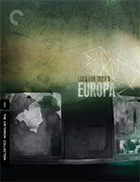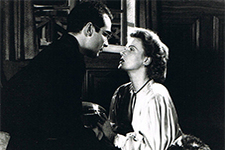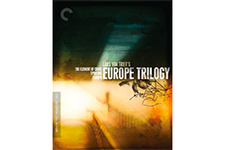| Director: Lars von Trier | | Screenplay: Lars von Trier & Niels Vørsel | | Stars: Jean-Marc Barr (Leopold Kessler), Barbara Sukowa (Katharina Hartmann), Udo Kier (Lawrence Hartmann), Ernst-Hugo Järegård (Uncle Kessler), Erik Mørk (Pater), Jørgen Reenberg (Max Hartmann), Henning Jensen (Siggy), Eddie Constantine (Colonel Harris), Max von Sydow (Narrator) | | MPAA Rating: R | | Year of Release: 1991 | | Country: Denmark / Sweden / France / Germany / Switzerland |  |
|  There is no denying that Lars von Trier’s Europa, his third feature film and the concluding entry in a loose symbolic trilogy about the end of Europe, is a visual masterpiece. Intricately designed and bold in concept, it mixes noir-ish black-and-white with jarring instances of color that look like they were shot with the old Technicolor two-strip film. The effect is slightly surreal, especially in the way there seems to be no inherent meaning to the use of color other than to draw attention to something in the frame. Even more crucial to the film’s visual sense is von Trier’s heavy reliance on front and rear projection to create a deeply layered image that subtly and not so subtly emphasizes the distinctions between foreground and background. Sometimes we’re not even aware that the foreground characters were shot independently of the background and then optically married in postproduction, but at other times von Trier uses the technologies (which are virtually as old as the cinema itself) to manipulate the environment, suddenly replacing a realistic background with something distorted or exaggerated. For all its technical and aesthetic brilliance, though, Europa remains a rather cold and distant film, one that is easy to appreciate, but difficult to love. The gliding camera movements and bravura mise-en-scene certainly flood your retinas and entice your senses, but the images are remote, never making the leap from head to heart. Perhaps it is because von Trier spent so much time working out the complex technical issues that he neglected to invest much in the film’s emotional underpinnings, or perhaps it is because the film is in various ways meant to be read as a metaphor, which each character and location playing a symbolic role related to postwar Europe. Or perhaps it is essentially the nature of the material, with its mixture of noir despair and Kafkaesque absurdity, that constantly keeps you at arm’s length. Europa opens with a sequence in which the legendary Max von Sydow literally hypnotizes us into the world of the film, which takes place in Germany in 1945, a few months after the end of World War II. Aside from the presence of hypnosis, the link between Europa and von Trier’s previous “Europe trilogy” films, The Element of Crime (1984) and Epidemic (1989), is the basic story, which involves a naïve idealist entering a hostile foreign land and finding some form of failure (von Trier’s compulsive animosity toward idealists has only grown throughout his career). In this case, the character is Leopold Kessler (Jean-Marc Barr), a young American who comes to Germany (which his father fled some time before the war) to take a job as a sleeping-car conductor on the recently revived Zentropa Railway. The job has been procured for him by his Uncle Kessler (Ernst-Hugo Järegård), a gruff and ugly man who is constantly berating Leopold and reminding him of his various duties. The story begins to develop the broad parameters of an espionage thriller when Leopold meets Katharina (Barbara Sukowa), the seductive daughter of Zentropa’s owner, Max Hartmann (Jørgen Reenberg). Leopold is drawn into the Hartmann family, which also includes Katharina’s troubled brother Lawrence (Udo Kier), where he finds conflict and turmoil that in various ways represents the travails of postwar Germany. Max was a Nazi sympathizer who allowed his railroad to be used to transport Jews to the concentration camps, while Katharina may or may not be involved with Werewolves, a pro-Nazi terrorist organization dedicated to sabotage as a means of disrupting the Allied occupation. And constantly circling around the margins is the impenetrably calm Colonel Harris (Eddie Constantine), an American officer who allows Max to escape punishment for his war crimes because his railroad is needed to reestablish stability in the country. (One could easily imagine Europa, played straight, as a wartime Hitchcock thriller, especially when the Bernard Herrmann-esque score is pounding on the soundtrack.) While the plot elements of Europa, however intricately interwoven, don’t last long in the mind, the visuals have a powerful resilience—dreamlike images of a child assassin shooting down a recently installed mayor, dozens of women dragging a locomotive out of a holding warehouse, blood spreading through a sink full of water from a man’s cut wrists, and a lengthy, agonizing sequence of drowning that replicates as closely as I can possibly imagine what the awful experience must be like. Working with three cinematographers‚—Henning Bendtsen (a 40-year veteran of the Danish film industry who shot two of Carl Theodor Dreyer’s last films), Edward Klosinski (a favorite of Krzysztof Kieslowski), and Jean-Paul Meuriss (a relative newcomer who would go on to work with Luc Besson)—von Trier has crafted a visually striking film that is somehow both extremely realistic (much of it was shot at various locations in Poland, including a bombed-out cathedral) and completely detached. The tone of the film is dark and somber, but with a sense of growing absurdity that reaches its fever pitch when Leopold is running frantically about the train trying to install a time-bomb while a pair of pedantic examiners attempt to test his knowledge of sleeping-coach protocol. In this regard, Europa is nothing if not intensely unique, even as it reassembles bits and pieces from recognizable films and genres using well-worn techniques and technologies. So much of it is so familiar, but from a distorted perspective, as if looking at a well-known painting through a prism; everything is simultaneously new and old. Robert Rodriguez and Frank Miller would essentially take this visual approach to its zenith using CGI in their graphic novel adaptation Sin City (2005), but von Trier should be justly appreciated for his vision so many years earlier. In interviews, von Trier has claimed that he was trying to make a “commercial” film, but what he really made was something truly visionary—messy and in some ways incomprehensible, but visionary nonetheless. | Europa Criterion Collection Blu-ray |  Europa is available as part of Criterion’s three-disc set “Lars von Trier’s Europe Trilogy,” which also includes The Element of Crime and Epidemic. Europa is available as part of Criterion’s three-disc set “Lars von Trier’s Europe Trilogy,” which also includes The Element of Crime and Epidemic. | | Aspect Ratio | 1.89:1 (Element of Crime)
1.66:1 (Epidemic)
2.39:1 (Europa) | | Audio | English Linear PCM 1.0 monaural (The Element of Crime)Danish Linear PCM 1.0 monaural (Epidemic)English/German Linear PCM 2.0 stereo (Europa) | | Subtitles | English | | Supplements | Audio commentary on The Element of Crime by director Lars von Trier, film and sound editor Tomas Gislason, and cinematographer Tom EllingAudio commentary on The Element of Crime by film scholar Peter Schepelern and filmmaker and critic Stig BjorkmanAudio commentary on Epidemci by von Trier and screenwriter and actor Niels VorselAudio commentary on Europa by von Trier and producer Peter Aalbwk JensenSelected-scene audio commentary on Europa by von Trier and actors Jean-Marc Barr and Udo KierTranceformer: A Portrait of Lars von Trier (1997) documentary by Stig Björkman“Storyboarding The Element of Crime” featurette“Anecdotes From The Element of Crime” featuretteInterview from 2005 with von Trier about the Europe TrilogyMaking-of documentaries for all three filmsPrograms on the films featuring interviews with many of von Trier’s collaboratorsTwo short student films by von Trier: Nocturne (1980) and Images of Liberation (1982) Danish television interview with von Trier from 1994“Portrait of Lars Von Trier” featurette “Anecdotes From Epidemic” featurette“From Dreyer to Von Trier” featurette“Anecdotes From Europa” featurette“Lars von Trier Anecdotes” featurette“The Emotional Music Script for Europa” featurette“A Conversation with Lars Von Trier” featurette”Trier’s Element” featuretteTrailersEssay by critic Howard Hampton | | Distributor | The Criterion Collection | | Release Date | January 17, 2023 | | | COMMENTS | | All three films in the “Europe Trilogy” have been newly scanned and restored. The Element of Crime and Epidemic were both scanned in 3K from the original 16mm camera negatives, while Europa was scanned in 4K from its original 35mm camera negative. Restoration work was carried out by Zentropa and approved by Lars von Trier. The transfer of The Element of Crime highlights with stunning clarity and great detail the film’s complex visual structure. As it is similar to a black-and-white film, the main challenge to the transfer was the contrast and black levels, both of which are mostly dead-on. Von Trier constantly infuses the frame with a great deal of hard contrast in the form of lights cutting through the darkness, and the transfer handles all of these scenes very well. The contrast between the sepia tones and the electronic bluish hues are also well-rendered. Epidemic is, simply put, an ugly movie, so even though the transfer is spot on, it still doesn’t look very good. The 16mm portions of the film are extremely grainy with a great deal of noise and hard contrast that makes parts of the image murky and other parts blown out, which is the intended look (or at least how it looked theatrically). The scenes shot on 35mm look much better, with a smoother sheen and good detail. The challenge with Europa is that virtually every shot in the film is an optical and is thus at best a copy of a copy. This results in the film having a slightly soft appearance, although it is sharp enough to make out plenty of detail in the often astounding visuals. The black-and-white image has good contrast and a nice range of grayscale, while the moments of color are appropriately desaturated and slightly unnatural. There is no information in the liner notes about the sources for the soundtracks. The Element of Crime and Epidemic are both in monaural while Europa is in stereo. The only film that sounds a bit problematic is Epidemic, which features quite a bit of aural hiss, but that is surely inherent to the low-budget film’s original soundtrack (and probably intentional). As far as supplements go, make sure you block out about a week of your life if you want to get through it all. Criterion has assembled a massive array of extras, most of which have been drawn from previous releases. We can start with the audio commentaries, of which there are five spread across the three films and all of which were recorded in 2005: The Element of Crime gets two, one from director Lars von Trier, film and sound editor Tomas Gislason, and cinematographer Tom Elling and one by film scholar Peter Schepelern, a professor at the University of Copenhagen, and filmmaker and critic Stig Bjorkman; Epidemic gets one by von Trier and screenwriter/actor Niels Vørsel; and Europa gets two, one by von Trier and producer Peter Aalbwk Jensen and then a selected-scene commentary by von Trier and actors Jean-Marc Barr and Udo Kier. Each of the discs is packed with additional supplements, most of which relate to that particular film, but others of which are more generally about von Trier and his work. On the Element of Crime disc we get Tranceformer: A Portrait of Lars von Trier, an excellent 1997 documentary by Stig Björkman that runs 54 minutes. Conveniently broken up into 10 chapters, it is a fine overview of von Trier’s complex and already controversial career. It includes extensive interviews with von Trier and his filmmaking associates, as well as footage of 8mm and 16mm films he made as a child and his work as a film student. (One complaint: The documentary does not use screen titles to note who the interviewees are, so you have to figure out who they are from the context of their statements.) The documentary covers both von Trier’s early work on his “Europe Trilogy” in the 1980s and his later output in the 1990s (with special emphasis on Breaking the Waves), concentrating on his consistent themes and his renown as a controversial director. “Storyboarding The Element of Crime” is an 11-minute interview from 2005 with cinematographer Tom Elling about how he and von Trier storyboarded the film. A 30-minute behind-the-scenes documentary from 1984 includes footage of the film in production and interviews with von Trier, actors Michael Elphick and MeMe Lai, and executive producer Per Hoist, among others. “Anecdotes From The Element of Crime” is a 20-minute featurette from 2005 that includes interviews with film scholar Peter Schepelern, film and sound editor Tomas Gislason, assistant director Ake Sandgren, executive producer Per Hoist, prop master Peter Grant, production manager Per Arman, gaffer Birger Larsen, and sound recordist Henrik Fleischer. Finally, the disc includes a trailer and two of the films von Trier made while he was studying at the National Film School of Denmark: the experimental Nocturne (1980) and Images of Liberation (1982), a drama about a German officer and his Danish mistress in the final days of World War II. The Epidemic disc opens with “Portrait of Lars von Trier,” a 1991 interview he gave for Danish teleivison. The 17-minute featurette “Anecdotes From Epidemic” includes interviews with screenwriter and actor Niels Vorsel, cinematographer Kristoffer Nyholm, actors Udo Kier and Michael Simpson, film scholar Peter Schepelern, and film consultant Claes Kastholm Hansen. The 150-minute featurette “From Dreyer to Von Trier” consists of an interview with cinematographer Henning Bendtsen, who, as the title suggests, began he career working with Carl Theodor Dreyer and ended with several of von Trier’s films (his second-to-last film was Europa. The disc also includes a very short trailer. The Europa disc starts with “The Making of Europa,” a 40-minute documentary produced in 1991 about the film’s production. Despite the rather shoddy video quality, the doc presents a fascinating journey from the elaborate process of storyboarding to the various stages of production, including behind-the-scenes footage on location and on the set and several interviews with von Trier. “Triers Element” is another 1991 documentary about the film’s production, although this one dedicates significantly more time to an interview with von Trier, and it also includes footage from the production of Dimension, a film von Trier started shooting in 1991 and plans to work on for three decades. “Anecdotes From Europa, a 20-minute documentary from 2005, is exactly what it sounds like: amusing anecdotes about the film’s production told by film historian Peter Schepelern, actor Jean-Marc Barr, producer Peter Aalbæk Jensen, assistant director Tómas Gislason, co-writer Niels Vørsel, and prop master Peter Grant (the best involve Jensen illegally bringing guns into Poland for the shoot and bribing notoriously difficult actor Ernst-Hugo Järegård with Cuban cigars). Also from 2005 are a series of video interviews with cinematographer Henning Bendtsen, composer Joachim Holbek, costume designer Manon Rasmussen, film-school teacher Mogens Rukov, editor Tómas Gislason, producer Peter Aalbæk Jensen, art director Peter Grant, actor Michael Simpson, production manager Per Arman, and actor Ole Ernst. There is also another 43-minute interview with von Trier recorded in 2005 in which he speaks extensively about the “Europe Trilogy.” Lastly, “The Emotional Music Script for Europa” is a 12-minute interview with composer Joachim Holbek. |
Copyright © 2023 James Kendrick Thoughts? E-mail James Kendrick All images copyright © The Criterion Collection |



 (3)
(3)

 Europa is available as part of Criterion’s three-disc set “Lars von Trier’s Europe Trilogy,” which also includes The Element of Crime and Epidemic.
Europa is available as part of Criterion’s three-disc set “Lars von Trier’s Europe Trilogy,” which also includes The Element of Crime and Epidemic.